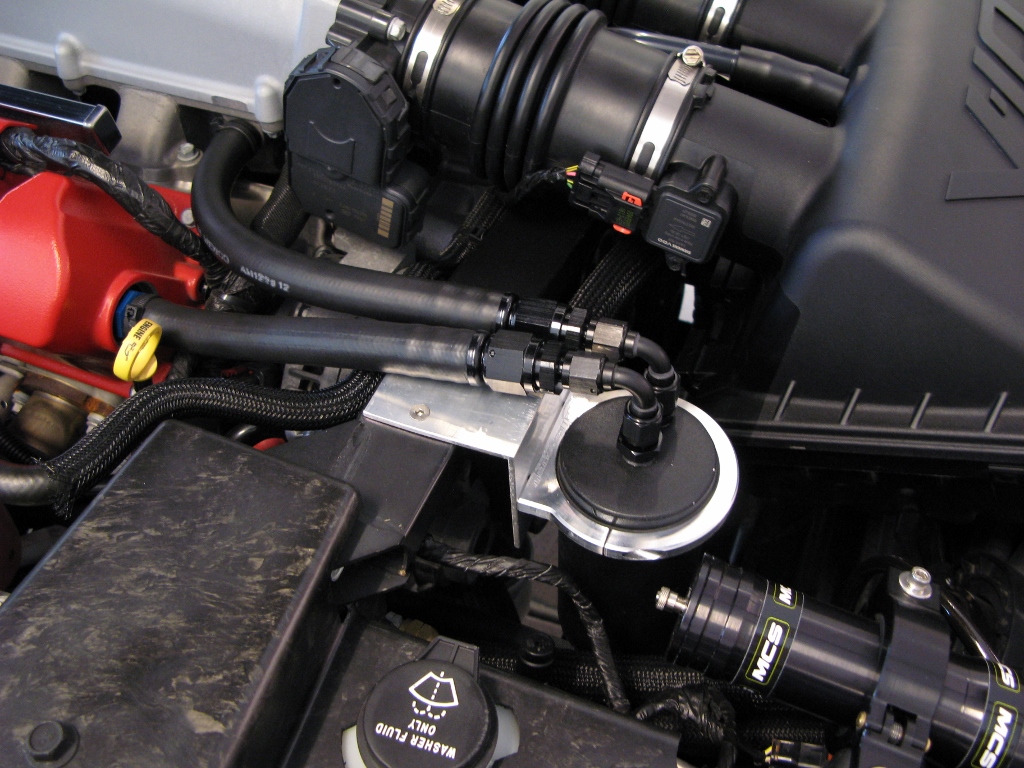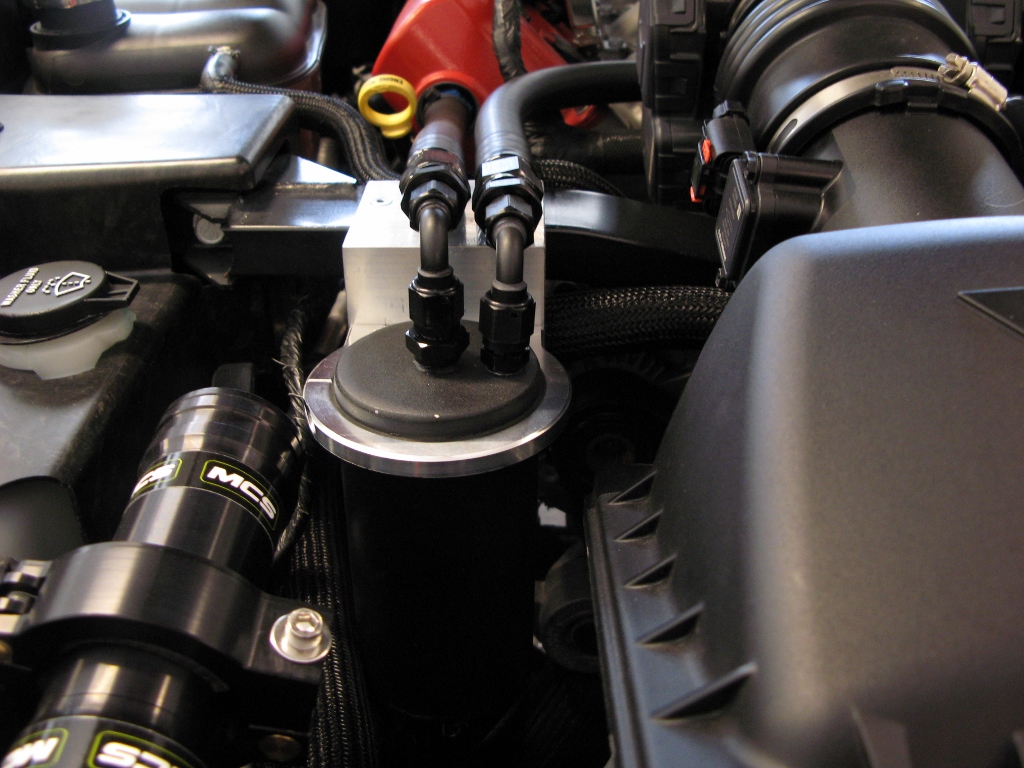Bottom line: IMO, yes you need an oil catch can, and you need one sooner than later. Even with only 9,500 miles on my Gen 4 when I bought it, I still has an nice oil glaze on the inside of my intake manifold, and I also had the nice oil snail trails coming out of both throttle bodies from too much oil being pulled in. The oil catch can I'm running has helped to pretty much eliminate that issue entirely. If there is oil getting by, it ain't much.
Results 51 to 75 of 132
-
07-24-2015 #51Enthusiast





- Join Date
- Oct 2013
- Location
- Dayton, OH
- Posts
- 4,803
-
07-24-2015 #52Enthusiast


- Join Date
- Oct 2013
- Location
- Brownsburg, IN
- Posts
- 1,786
Thanks SteveM, you're essentially an automotive encyclopedia!
-
07-24-2015 #53
-
07-24-2015 #54Enthusiast


- Join Date
- Dec 2013
- Posts
- 205
...
Last edited by RAY W; 07-24-2015 at 10:26 PM.
-
07-24-2015 #55Enthusiast


- Join Date
- Oct 2013
- Location
- Deadmonton, Albertastan, Canada
- Posts
- 1,524
I have a proper RX catch can but I'm trying to figure out how to plumb it into the Viper system as it has 2 inlet hoses and 1 outlet hose. Possibly use both valve covers as inlets and feed the outlet to the intake piping?
-
07-24-2015 #56Enthusiast





- Join Date
- Oct 2013
- Location
- Dayton, OH
- Posts
- 4,803
I've always liked the quote "Gentlemen, we have run out of money; now we have to think." At this point in my life, I'm a little short on money, but researching problems and solutions is generally free. A catch can is one of those often overlooked items that can potentially have a big impact on the performance of any car, especially one as powerful as a Viper.
Here's a couple shots of my RX can:


I ordered mine with one inlet and one outlet. If you put the can under vacuum (like I have mine hooked up), you will only want to hook one valve cover up to it. There needs to be a source of makeup air (driver's side cover in this case) that is not under vacuum for the system to function properly.
-
07-24-2015 #57Enthusiast



- Join Date
- Oct 2013
- Location
- Ohio
- Posts
- 3,889
-
07-24-2015 #58Enthusiast





- Join Date
- Oct 2013
- Location
- Dayton, OH
- Posts
- 4,803
-
07-24-2015 #59Enthusiast


- Join Date
- Oct 2013
- Location
- Deadmonton, Albertastan, Canada
- Posts
- 1,524
It's because it's a RX can... Not a typical catch can.
-
07-24-2015 #60Enthusiast





- Join Date
- Oct 2013
- Location
- Dayton, OH
- Posts
- 4,803
-
07-24-2015 #61Enthusiast


- Join Date
- Oct 2013
- Location
- Deadmonton, Albertastan, Canada
- Posts
- 1,524
Thanks for your help

I have the dual monster: http://www.rxspeedworks.com/product/catch-can-kits/
-
07-25-2015 #62Enthusiast


- Join Date
- Apr 2015
- Location
- Bradenton, Florida
- Posts
- 280
-
07-26-2015 #63Enthusiast


- Join Date
- May 2015
- Posts
- 483
Please count me down for one.
Thanks
-
07-26-2015 #64Enthusiast


- Join Date
- Oct 2013
- Location
- Brownsburg, IN
- Posts
- 1,786
Fittings and hose will likely be slightly different depending on the end user install, there will probably be a few places to mount the can and a few different configurations (read through this thread for some background info). For an idea on how I routed the can for my Gen IV (with Gen V intake manifold), see the following:
http://dougshelbyengineering.com/upl...acket_Rev2.pdf
-
07-26-2015 #65Enthusiast


- Join Date
- Oct 2013
- Posts
- 4,693
-
07-26-2015 #66Enthusiast


- Join Date
- Apr 2015
- Location
- Silver Springs FL
- Posts
- 2,399
SO can I have one please?

-
07-26-2015 #67Enthusiast


- Join Date
- Oct 2013
- Posts
- 4,693
Next question: since you're not venting to atmosphere, you're not violating emission laws. So why are hi-po cars factory equipped with catch cans?
-
07-26-2015 #68Enthusiast





- Join Date
- Oct 2013
- Location
- Dayton, OH
- Posts
- 4,803
I'm sure there are many reasons, but off the top of my head:
1. Something else to design, manufacture, and install - for something like a Corvette with a large production run, this would likely eat into profits
2. Most manufacturers seem to think this issue can be addressed with well-designed PCV systems that incorporate fancy baffling to eliminate this issue - the LT1 in the C7 Corvette comes to mind. I remember reading about their newest patented PCV system that was supposed to eliminate this issue entirely...it's a big issue for direct injected engines because you no longer have fuel spraying on the intake valves to wash the oil gunk off. To the best of my knowledge, the LT1 still suffers from PCV-related oil ingestion issues.
3. It is something else for the end-user to have to maintain.
4. Maintenance of this system means you have to get rid of this gunk somehow - you can't just pour it back into the engine oil, and I'm sure the EPA would like you to do something with it other than dump it. That's why they want it burned off in the combustion chamber, your engine be damned.
-
07-26-2015 #69Enthusiast


- Join Date
- Oct 2013
- Posts
- 4,693
Steve, I think you nailed it with point number 4!
-
08-05-2015 #70Enthusiast


- Join Date
- Oct 2013
- Location
- Brownsburg, IN
- Posts
- 1,786
The initial test fit went well for both locations. Many thanks to the vehicle donor!
IMG_6861.jpgIMG_6862.jpgIMG_6863.jpgIMG_6864.jpg
Next I need to confirm some plumbing and other details to ensure there are no mechanical conflicts before setting up a group buy.
Doug
-
08-09-2015 #71Enthusiast


- Join Date
- Oct 2013
- Location
- San Antonio
- Posts
- 652
Great explaination. I have an ACR that I track so I went with the ACRX can, figured a lot of money went into designing it, why try to rethink it. And it is full after a hard track weekend. On road it takes 2-3k miles to fill it up.
This is new solution would be going on my '15 TA2.0 also a track car for me. If I could do a single mount dual inlet vented AWESOME. Just need to check clearances. If not a dual can system looks like it would work.
for street only applications a passenger only side should work, however there is still a chance of oil ingestion from both sides, so even a street only car would benefit from a dual can or ACRX style set up I would assume.
-
09-06-2015 #72Enthusiast


- Join Date
- May 2015
- Posts
- 483
Any updates ?
-
09-06-2015 #73Enthusiast


- Join Date
- Oct 2013
- Location
- Brownsburg, IN
- Posts
- 1,786
Had to reboot with a smaller can so that Bracket is underway. The gen V engine bay is tight. There will be a dual input vented and also a single input sealed option.
Last edited by SSGNRDZ_28; 09-06-2015 at 10:53 AM.
-
09-29-2015 #74Enthusiast


- Join Date
- Oct 2013
- Location
- Pittsburgh
- Posts
- 1,634
Any updates?
-
09-29-2015 #75Enthusiast


- Join Date
- Oct 2013
- Location
- Brownsburg, IN
- Posts
- 1,786
I'm pulling parts together for the two kits. I hope to offer the bracket(s), can(s), hoses, fittings, etc as a kit. The new brackets are done. I need to do a test fit to see what works best as soon as I have everything ready. The new catch cans are nice and compact and also cheaper than the Radium offering.
Last edited by SSGNRDZ_28; 09-29-2015 at 09:42 PM.



 Reply With Quote
Reply With Quote

Bookmarks